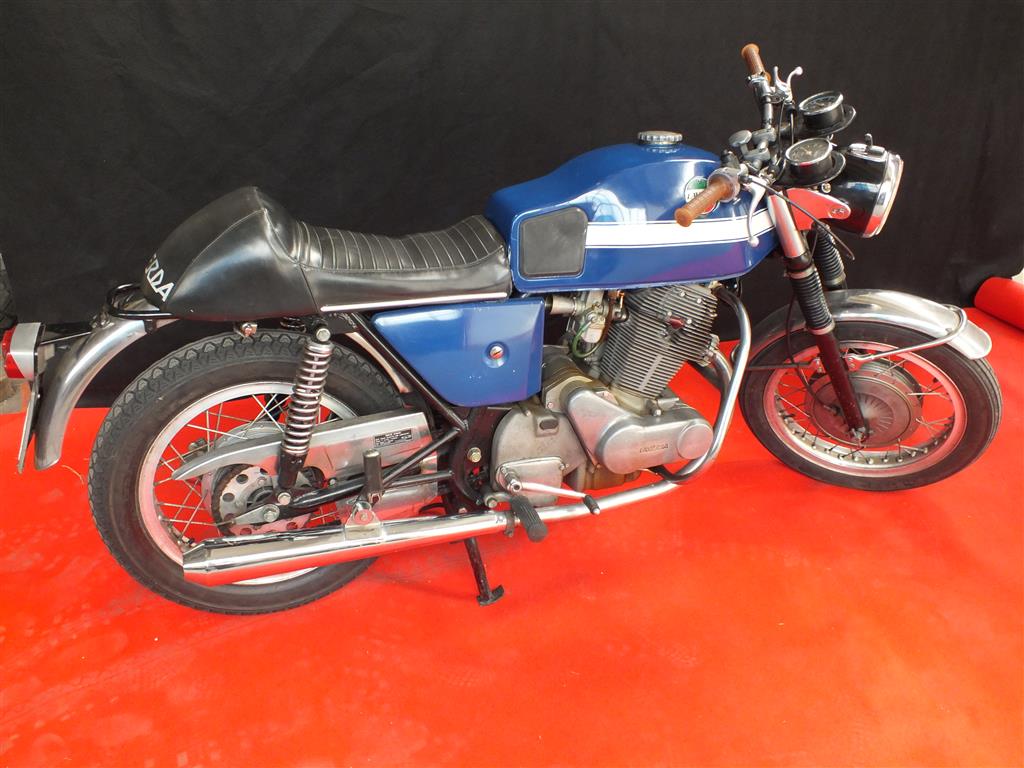
| Make: | LAVERDA |
| Model: | 750 S |
| Year: | 1970 |
| Condition: | excellent / original |
| Owners: | 1 |
| Chassis no.: | LAV750S***6 |
| Engine: | LAV750***6 |
| Capacity: | 744cc |
| Power: | 60/44 hp/kW |
| Gearbox: | 5 speed |
| Km: | 24026 |
| Price: | 14.50 |
Founded in 1947 by Francesco Laverda, Moto Laverda started out life at Breganze in the province of Vicenza producing motorcycles. The first model, the Laverda 75, was officially presented in 1950. The commitment to racing and the successes in various editions of the Giro d'Italia, Motogiro and Italian enduro championships, together with a long series of wins in national and international races with the Laverda 75 and, from 1955, the Laverda 100 enabled the small company to grow. Until the mid-1960s, production consisted largely of small capacity motorcycles, mopeds and scooters.
Then, in July 1958, the Laverdino 48, a 4-stroke moped, was presented; a year later, the 49 cc scooter was launched and in 1961 came the 200 cc Twin. The turning point arrived at the end of the 1960s when Massimo Laverda, son of the founder, Francesco, decided to orient production towards high capacity bikes. As early as 1968, introduction of the Laverda 650 cc was greeted enthusiastically by the public, but the greatest success came in the 1970s with the Laverda 750, exported throughout the world and paving the way for a highly successful series of sports bikes which turned the Breganze make into a legend.
The 750 GT was joined in early 1969 by the 750 S ('S' standing for 'Sport'). This was built until late 1970, when the two models effectively merged to become the SF ('Super Freno', meaning 'super brake') model. The differences in styling between the GT and S affected the handlebars, seat, fuel tank, mudguards (the GT having square-section, the S rounded, both enjoying the luxury of stainless-steel assemblies), and front forks (the GT having enclosed, the S exposed fork tubes, both 35mm Ceriani).
There were also several differences between the two models in the state of tune. The carburettors on the GT were equipped with an air filter, the S's were not, having polished bellmouths instead. The GT ran a 7.7:1 compression ratio, the S 9:1. The S used a 1mm larger carb size than the GT 30 (against 29mm); both were of the square slide VHB type. The GT used a softer camshaft profile (8) than the S (4/s).
In the power stakes, the GT produced 52 bhp @ 6,600rpm against the S version's 60bhp @ 6,600rpm. In terms of the fuel tank, the GT shared the same 19-litre (4.2-gallon) capacity as the 650GT, against the 20-litre (4.4-gallon) capacity for the 750S.
With its orange colour giving it high style impact, between 1968 and 1976, the Laverda SFC racing version clocked up a packed series of wins in races reserved for standard bikes from the Motogiro d'Italia in 1968 to enduro and speed races throughout Europe.
From the mid-1970s, production of the 1000 and 1200 maxi bikes stepped up, although the design idea for a 1000 dates back to the end of the 1960s, along with the SF 750.Production of the Laverda 1000 in the various versions from the 3 CL to the Jota continued until the end of the 1980s. The Laverda 1000 RGS (Real Gran Sport) introduced at the 1981 Milan Motor Show was particularly well appreciated.
From the 750 SF in all its various versions to the RGS, the distinctive Laverda orange found a place in the heart of enthusiasts who appreciated the character and performance typical of Italian supersports bikes.
* required.